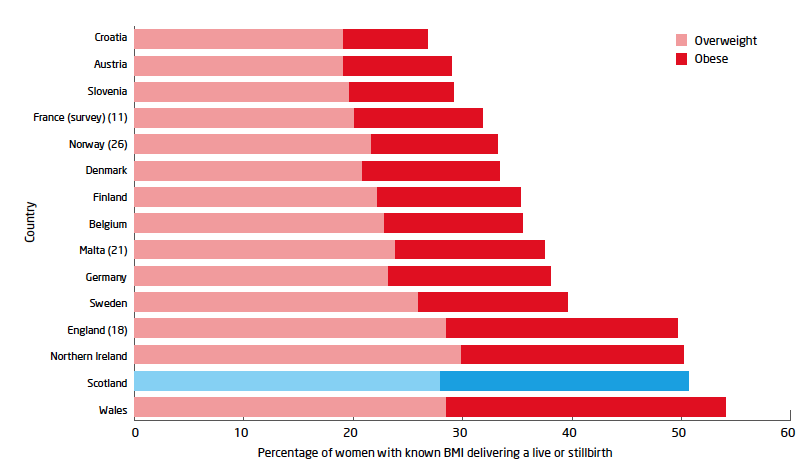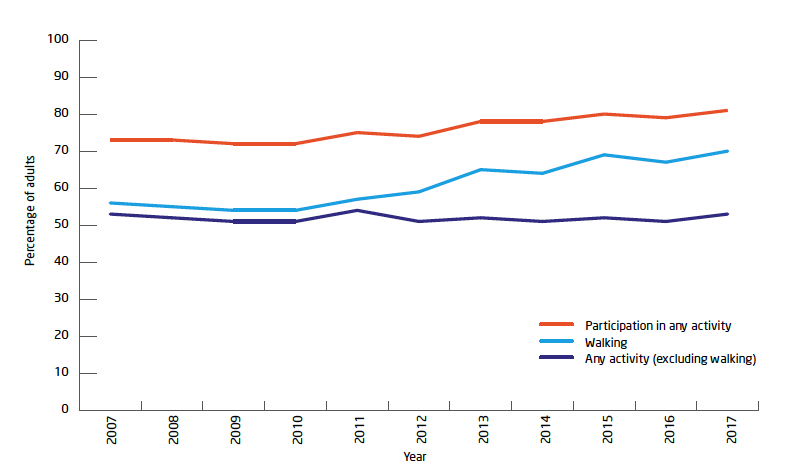Chief Medical Officer for Scotland’s Annual Report summary 2017-2018: annex
The Chief Medical Officer's A Summary of the Health of the Nation provides data on some of the key issues related to Scotland’s health.
Priority 6 – A Scotland Where We Eat Well, Have A Healthy Weight and Are Physically Active
We want everyone in Scotland to eat well, have a healthy weight and enjoy being physically active. Reducing the future risk of overweight and obesity and increasing levels of physical activity in Scotland require substantial changes to our 'obesogenic' environment.
Diet, physical activity and weight are influenced strongly by wider environments. Sustained and coordinated action is required to promote easy access to affordable, nutritious food, to ensure communities are protected from the intrusive marketing of unhealthy food, and to provide safe and appealing opportunities for active travel and leisure.
A range of information sources on diet, physical activity, and weight are available for Scotland. Here, we focus on overweight and obesity trends among women in early pregnancy (maternal obesity) and on physical activity levels (in particular walking) in the wider population.
Maternal Obesity
Maternal obesity is a marker of unhealthy weight levels in the general adult population. This topic has been selected to illustrate the problem of obesity because it carries particular short and long-term risks for women and their children.
Women who are overweight or obese are at higher risk of a range of complications during pregnancy, including pregnancy-related diabetes and high blood pressure, and are more likely than women of a healthy weight to require a caesarean section. Their babies are at increased risk of certain congenital anomalies, of having excessively low or high birth weight, and of being born prematurely. Maternal overweight and obesity increases the risk of the most severe adverse pregnancy outcomes for mother and baby, including severe maternal illness, death and stillbirth. Overweight and obesity beyond pregnancy is associated with long-term risks to women's health, for example type 2 diabetes, certain cancers, and joint problems.
Maternal overweight and obesity is also strongly associated with child overweight and obesity, which in turn poses short and long-term health risks for the child.
Figure 10: Percentage of women giving birth who were overweight (BMI 25-<30) or obese (BMI >=30) during early pregnancy in 2015.

Source: Euro-Peristat project[5]
Footnote:
Data shown for all countries that provided figures to Euro-Peristat. The % of women delivering in 2015 who had unknown/missing BMI data is shown in brackets after the country name for countries with ≥10% missing data
The Euro-Peristat project provides information on the proportion of women delivering a baby in 2015 who were overweight (body mass index [BMI] 25-<30) or obese (BMI ≥30) in early pregnancy, generally at the time of antenatal booking. All four UK nations but only 15 of the 34 countries submitting data to Euro-Peristat were able to provide information on maternal BMI. The proportion of mothers with overweight or obesity was noticeably higher in each of the four UK nations than in any other country. In 2015, over half (51%) of women giving birth in Scotland were overweight (28%) or obese (23%) at the time of antenatal booking.
Recording of maternal height and weight at antenatal booking has been mandatory on national maternity records since April 2011. The proportion of women with known BMI who were overweight or obese has increased steadily since then, from 49% of those delivering in 2011/12 to 52% in 2017/18. High levels of maternal overweight and obesity in Scotland reflect the situation in the general adult population. For example, the Scottish Health Survey found that in 2017, 54% of women aged 25-34 years in the general population were overweight or obese.
Information from Euro-Peristat suggests that maternal obesity rates are increasing in most, but not all, countries with trend data available. Between 2010 and 2015, the maternal obesity rate remained the same in Denmark and decreased in Norway. This suggests that Scotland could look to international partners to explore what combination of policies and services could best counteract our high and increasing obesity levels.
Although maternal overweight and obesity is common throughout Scotland, it disproportionately affects women living in more deprived areas. Among women delivering in 2017/18, 56% of those from the 20% most deprived areas of Scotland were overweight or obese at booking compared to 44% of women from the 20% least deprived areas.
Physical Activity
There is strong evidence that increasing a person's amount of everyday activity can prevent and treat common and disabling health conditions, such as heart disease, type 2 diabetes and depression.
The recommended level of activity for gaining health benefits is 150 minutes of moderate intensity activity over the course of the week. This may be walking, running, swimming or other sports activities.
We focus here on walking as an indicator of physical activity because, for most people, walking is the easiest mode of physical activity to adopt. It requires no new skills or equipment and can be done as part of everyday life, making the 150 minute target feasible to achieve. Many sports and activities have greater rates of participation amongst men, younger people and those in the most advantaged social classes. For walking, the differences in participation by gender, age and socio-economic status are smaller.
The percentage of people in Western European countries achieving the recommended 150 minutes of weekly activity is decreasing.[19] This is not the case in Scotland. The Scottish Health Survey shows that two-thirds of adults achieve the 150 minute target and that, since 2012, there has been an increase in the percentage achieving this target. It is likely that much of this increase can be attributed to walking.[20] Scotland has a walking strategy which, along with efforts from Scottish Government and partners such as Paths for All, has contributed to increases in the proportion of people taking part in walking.[21,22 ]
Figure 11 shows an increase in overall participation in any activity and in walking since 2007, based on results from the Scottish Household Survey. When walking is excluded, participation levels do not increase, showing the importance of the contribution of walking to the increasing overall levels of physical activity.
Figure 11: Trends in adult participation in physical activity and sport in Scotland from 2007 to 2017

Source: Scottish Household Survey[20]
Footnote: Minimum base: 9,130
Contact
Email: stephen.fenning@gov.scot
There is a problem
Thanks for your feedback